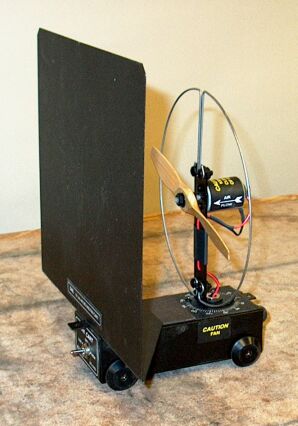
The fan on this cart blows air in the direction of the arrow painted on the side of the motor (towards the left as the apparatus is shown in the photograph). It has two settings, “Low” and “High.” With the fan pointed as shown, that is, blowing in the direction of the long axis of the cart, but without the sail on the cart, the cart experiences the maximum acceleration to the right for either setting. With the sail placed as shown, with the fan on the “High” setting, the cart accelerates slowly towards the left. The fan mount is on a pivot, so that if you wish, you can rotate it to set the air flow at any angle you wish, with respect to the long axis of the cart.
This demonstration provides an illustration of Newton’s third law of motion, which states (as quoted in Resnick, Robert and Halliday, David. Physics, Part 1, Third Edition (New York: John Wiley and Sons, 1977), p. 79) To every action there is always opposed an equal reaction; or, the mutual actions of two bodies upon each other are always equal, and directed to contrary parts.
The cart is free to roll in the direction of its long axis. With the fan set as shown in the photograph (but without the sail on the cart), it blows air to the left, in the direction of the long axis of the cart. In blowing the air to the left, the fan exerts a leftward force on the air, which must in turn exert an equal rightward force on the fan. Since the fan is rigidly mounted to the cart, this rightward force on the fan accelerates the cart to the right. The fan has two settings, “Low” and “High.” The fan speed, and thus the rate of air flow through the fan, and in turn, the acceleration of the cart, is greater for the “High” setting than for the “Low” setting.
The fan is mounted on a pivot, which allows you to rotate it to any desired angle with respect to the long axis of the cart. With the fan pointed in the direction of the long axis of the cart (an angle of 0°), as shown in the photograph above, the air flow is completely along the axis of the cart. The force exerted on the cart by the air flow is thus also completely along the axis, and the acceleration of the cart is the maximum it can be for either fan setting. If you increase the angle at which the fan sits, the air flow now has two components with respect to the cart axis – one along the axis, and one perpendicular to it. The force generated by the fan thus also has these two components. If we call the force exerted on the cart by the air flow when the fan is set at 0° Fmax, then the force on the cart for the fan at any angle is F = Fmax sin θ.
We see from this that as we increase the fan angle from zero, the axial component of the air flow, and thus F, the force on the cart, decreases until the angle equals 90°, at which point there is no axial component to the air flow, and F equals zero. With the fan in this position, the cart does not accelerate at all. If we continue to turn the fan past 90°, the axial component of the air flow changes sign, and the direction in which the cart accelerates is reversed.
If you place the sail on the cart as shown in the photograph, it reverses the air flow, and the cart accelerates in the opposite direction to the direction in which it accelerated without the sail. Because the air flow diverges considerably when it comes back from the sail, the force it generates along the cart axis is rather small. To demonstrate this effect of the sail, you must use the “High” setting for the fan, and the sail cannot be too close to the fan.